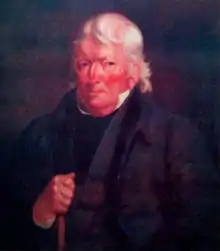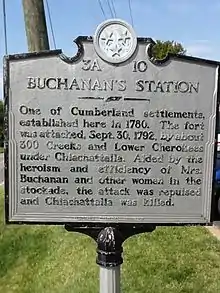"Major" John Buchanan
"Major" John Buchanan (born January 12, 1759) was an American frontiersman and one of the founders of present-day Nashville, Tennessee. He is best known for defending his fort, Buchanan Station, from an attack by several hundred Native American Indians on September 30, 1792.[1] The defense at Buchanan's Station saved early Nashville, which was unprepared after dismissing rumors of an incoming Indian onslaught. On their part, the Indians recoiled, splitting into small parties that caused considerable damage to outlying homesteads but abandoned the major attack on Nashville. Nor was any like invasion attempted again. The defense of Buchanan's Station not only spared Nashville, but raised the morale of the pioneers at a dark and difficult time, and was frequently recalled in the following decades as a symbol of the courage and determination of the founders of the state of Tennessee.
"Major" John Buchanan | |
|---|---|
 | |
| Born | January 12, 1759 |
| Died | November 7, 1832 |
| Occupation | American pioneer, settler, frontiersman, farmer, |
Origins
Major Buchanan's roots can be traced to Anselan O Kyan, the son of the King of Ulster Dermond O Kyan of Ireland and the founder of the Buchanan clan. Anselan fled Ireland and landed on the northern coast of Argyll, Scotland near The Lennox north of the present day city of Glasgow, around the year 1016. Anselan assisted Malcolm II of Scotland in repelling his old enemies, the Danes, on two different occasions. Anselan received a grant of land in the north of Scotland, East of Loch Lomond.[2] The Buchanan name bears a unique Coat of Arms and specific war cry granted to Anselan.[2]
John Buchanan was the great-grandson of Thomas Buchanan, who left Scotland in 1702 as one of six brothers (John, William, George, Thomas, Samuel, and Alexander) and one sister to resettle in County Donegal, Ireland. John Buchanan and his wife, Jane Trimble, emigrated to America as among the earliest colonists in North America, initially settling in Harrisburg, Pennsylvania, where Major John Buchanan was born in 1759.[3]
Settlement in Cumberland
Twenty-year-old John Buchanan and his family arrived at the future Nashville during the unusually cold winter of 1779–1780, ahead of James Robertson's founding party according to several historians. After losing his brother Alexander at Ft. Nashborough's 1781 "Battle of the Bluff," Buchanan wrote Nashville's first book, John Buchanan's Book of Arithmetic.[4]
After living approximately four years at Fort Nashborough, Buchanan and his family moved a few miles east and established Buchanan's Station on Mill Creek, at today's Elm Hill Pike and Massman Drive in Nashville. Around 1786, Buchanan married Margaret Kennedy, who died after giving birth to their first and only child, John Buchanan II, born on May 15, 1787. His second wife, Sarah Ridley, bore thirteen children: George, Alexander, Elizabeth, Samuel, William, Jane T., James B., Moses R., Sarah V., Charles B., Richard G., Henry R., and Nancy M.
As G.R. McGee writes in A History of Tennessee from 1663 to 1905, “[i]n the summer of 1780 the Indians began to kill the settlers and hunters that they found alone or in small parties, and this was kept up all the season. There was no open attacks upon the settlements, but if a man went out to gather corn, to hunt, to feed his stock, or to visit a neighbor he was in constant danger of being shot by an Indian hidden away in a thicket or canebrake."[5]
Attack on Buchanan's Station

On September 30, 1792, during the height of the Cherokee–American wars, approximately twenty defenders at Buchanan's Station held off several hundred Native Americans seeking to destroy all the Cumberland settlements. Buchanan and his compatriots stopped them—without the loss of a single stationer—before they could move on to attack the remainder of area settlements. Nineteenth-century historian J.G.M. Ramsey called this victory "a feat of bravery which has scarcely been surpassed in all the annals of border warfare."[6]
Buchanan's Station was located on Mill Creek and consisted of a few buildings surrounded by a picket stockade and a blockhouse at the front gate overlooking the creek some four miles south of the infant settlement of Nashville.[7] For most of the 19th century, Buchanan's Station was widely remembered as a symbol of the determination that created the State of Tennessee.[7]
At the time, Nashville consisted of only about sixty families, and it was isolated in a hostile and threatening wilderness. Communications with the nearest settlements, Knoxville in eastern Tennessee and Natchez further south on the Mississippi, were long and precarious. Although the ultimate responsibility for the area had been transferred from North Carolina to the United States federal government in 1790, neither entity had the will or resources to offer the small outpost effective protection. Ranged against it were Native Americans, understandably aggrieved at the loss of traditional territory, and international powers. Threatened by the rise of the new American republic, Britain and Spain both encouraged Indian confederacies to resist its expansion and create a buffer between it and their own colonial possessions. North of the Ohio, the British saw Indians as an essential part of the defense of Canada, while Baron Carondelet, the governor of Spanish territory south of the 31st parallel and west of the Mississippi, armed the southern Indians and urged them to unite against the Americans. It was time, one Spanish correspondent wrote, to “place an obstacle to the rapid western progress of the Americans and raise a barrier between these enterprising people and the Spanish possessions.” In these circumstances the positions of isolated American pioneer settlements was unenviable, and in 1792 Bledsoe's and Ziegler's stations north of Nashville were overrun by parties of Indians smaller than the one that attacked Buchanan's later in the year.
The assault on Buchanan's Station was not a simple raid, but an attempt to wipe out the Nashville settlements entirely, backed by Spanish arms and supplies secured in Pensacola.[7] Over three hundred Lower Cherokees, Creeks, and Shawnees under the command of a mixed blood Cherokee leader named John Watts, advanced on Nashville from their towns on the lower Tennessee River.[7] Supposing that the outlying station of Buchanan could be disposed of quickly, the Indians attempted a surprise attack at midnight. The station contained only a handful of defenders, some fifteen men, who manned the port-holes while their women and children—led by Buchanan's wife—molded bullets, reloaded muskets and rifles, and supplied sustenance.[7] During a furious fight, the Indians attempted to storm the palisade and to set fire to the roof of the blockhouse, but they were repelled within two hours.
Sally Ridley Buchanan
It was during this nighttime "Battle of Buchanan's Station" that Buchanan's eighteen-year-old wife, Sarah ("Sally") Ridley Buchanan, in her ninth month of pregnancy with the first of their thirteen children, earned national fame. She encouraged the men, reassured the women and children, molded much-needed ammunition reportedly by melting down her dinnerware, and provided the voice of victory throughout the seemingly hopeless pandemonium.[7] For her uncommon valor, she was known as the "Heroine of Buchanan Station" and biographer Elizabeth Ellet referred to her as “the Greatest Heroine of the West.”[8] Sally was heralded in magazines and newspapers as well as listed in at least two national encyclopedias of biography (Appleton's and Herringshaw's).
Additional Information
References
- Aiken, Leona Taylor (1968). Donelson, Tennessee: Its History and Landmarks.
- "Buchanan Society". Archived from the original on January 25, 2013. Retrieved February 18, 2013.
- Buchanan, Thomas. "Thomas Buchanan's Memoirs – 1898". Retrieved May 27, 2013.
- Buchanan, John (1781). John Buchanan's Book of Arithmetic. site of present-day Nashville, TN: Buchanan, John. p. 82. Tennessee Historical Society miscellaneous collection, I-A-1v, B-238, T-100.
- McGee, Gentry Richard (1911). A History of Tennessee from 1663 to 1914. New York: American Book Company. pp. 88–89.
- Ramsey, J.G.M. (1853). Annals of Tennessee.
- Sugden, John (1997). Tecumseh: A Life. Henry Holt and Company. pp. 73–76. ISBN 9780805061215.
- Ellet, Elizabeth (1856). The Women of the American Revolution.